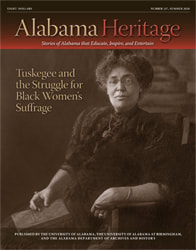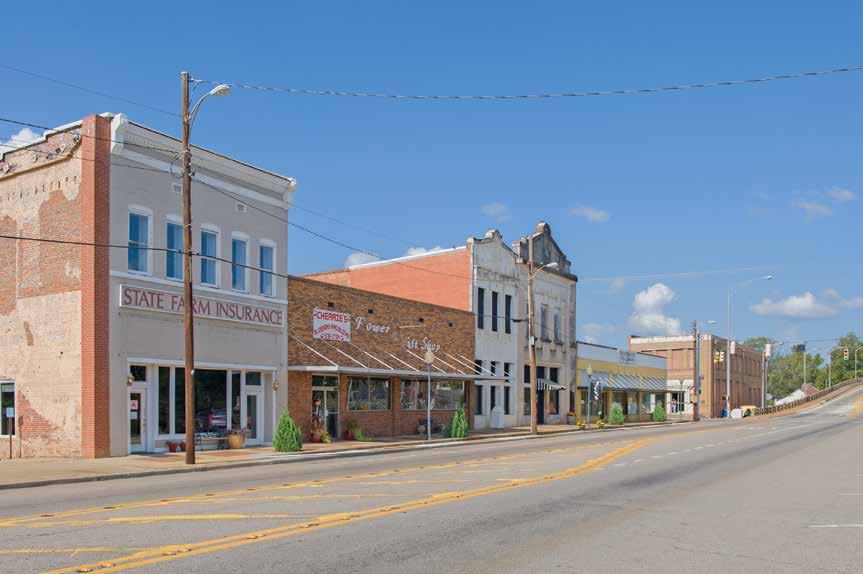|
On the cover: Margaret Murray Washington, the wife of Booker T. Washington, led the Black women of Alabama in the movement to win the right to vote. (Library of Congress)
|
FEATURE ABSTRACTS
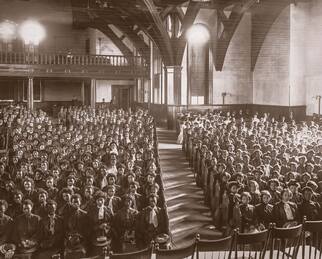 The female students of Tuskegee Institute gathered in the chapel, c. 1902. Margaret Murray Washington believed training Black women to be good citizens was more important than promoting women’s suffrage. (Library of Congress)
The female students of Tuskegee Institute gathered in the chapel, c. 1902. Margaret Murray Washington believed training Black women to be good citizens was more important than promoting women’s suffrage. (Library of Congress)
The New Negro Suffragist
Tuskegee Clubwomen and the Fight for Suffrage
By La-Kisha Emmanuel
Though many fought for suffrage up through the early twentieth century, they were typically focused on voting rights for white women. While activists such as Susan B. Anthony garnered attention for their cause, numerous Black women throughout the country worked to advance their own cause. Women’s clubs—including one at the Tuskegee Normal and Industrial Institute, formed in 1895 by Margaret Washington (wife of Booker T. Washington)—offered educational, social, and cultural programming as they worked to advance the status of African Americans in the United States.
About the Author
La-Kisha Emmanuel is a history PhD student at New York University. Her research examines the intellectual labors and transnational networks of rural African American clubwomen in the late-nineteenth- and early twentieth-century American South. Prior to pursuing a PhD, she earned an MA in women’s studies and history from the University of Alabama and received her BA in history from Stillman College. Emmanuel recently interned for the Equal Justice Initiative in Montgomery, Alabama, where she supported its Legacy Museum and National Memorial for Peace and Justice. She has also volunteered as a researcher for the Rosa Parks Museum in Montgomery. Her past fellowships include the Smithsonian National Museum of African American History and Culture Robert Frederick Smith Fellowship and the McNair Graduate Fellowship.
Additional Information
Tuskegee University:
http://encyclopediaofalabama.org/article/h-1583
https://www.tuskegee.edu/
Tuskegee University Archives:
https://www.tuskegee.edu/libraries/archives
NPS Article: Between Two Worlds: Black Women and the Fight for Voting Rights
https://www.nps.gov/articles/black-women-and-the-fight-for-voting-rights.htm
NEH article: How Black Suffragists Fought for the Right to Vote and a Modicum of Respect
https://www.neh.gov/article/how-black-suffragists-fought-right-vote-and-modicum-respect
Tuskegee Clubwomen and the Fight for Suffrage
By La-Kisha Emmanuel
Though many fought for suffrage up through the early twentieth century, they were typically focused on voting rights for white women. While activists such as Susan B. Anthony garnered attention for their cause, numerous Black women throughout the country worked to advance their own cause. Women’s clubs—including one at the Tuskegee Normal and Industrial Institute, formed in 1895 by Margaret Washington (wife of Booker T. Washington)—offered educational, social, and cultural programming as they worked to advance the status of African Americans in the United States.
About the Author
La-Kisha Emmanuel is a history PhD student at New York University. Her research examines the intellectual labors and transnational networks of rural African American clubwomen in the late-nineteenth- and early twentieth-century American South. Prior to pursuing a PhD, she earned an MA in women’s studies and history from the University of Alabama and received her BA in history from Stillman College. Emmanuel recently interned for the Equal Justice Initiative in Montgomery, Alabama, where she supported its Legacy Museum and National Memorial for Peace and Justice. She has also volunteered as a researcher for the Rosa Parks Museum in Montgomery. Her past fellowships include the Smithsonian National Museum of African American History and Culture Robert Frederick Smith Fellowship and the McNair Graduate Fellowship.
Additional Information
Tuskegee University:
http://encyclopediaofalabama.org/article/h-1583
https://www.tuskegee.edu/
Tuskegee University Archives:
https://www.tuskegee.edu/libraries/archives
NPS Article: Between Two Worlds: Black Women and the Fight for Voting Rights
https://www.nps.gov/articles/black-women-and-the-fight-for-voting-rights.htm
NEH article: How Black Suffragists Fought for the Right to Vote and a Modicum of Respect
https://www.neh.gov/article/how-black-suffragists-fought-right-vote-and-modicum-respect
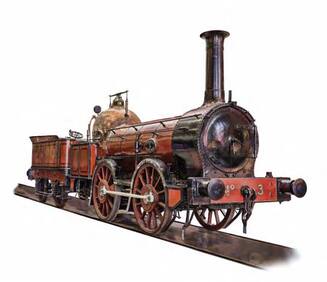 Coppernob, 1846: A Preserved Edward Bury & Company 0-4-0 Locomotive (National Railway Museum, York, United Kingdom).
Coppernob, 1846: A Preserved Edward Bury & Company 0-4-0 Locomotive (National Railway Museum, York, United Kingdom).
Industrial Revolution
The Locomotive Comes to Alabama
By Ken Boyd
Nearly two hundred years ago, the first steam locomotive passed through Alabama, indelibly changing transportation in the young state—and the nation. Though it was just one product of the Industrial Revolution, the locomotive remains a significant part of the state’s history. Photographer Ken Boyd offers this richly photographed history of trains in Alabama, chronicling generations of locomotives that have chugged across the state.
About the Author
Ken Boyd has been a passionate, enthusiastic, and award-winning photographer and writer for more than four decades. He has published two popular and internationally distributed books on locomotives entitled Historic North American Locomotives (Kalmbach Publishing Company, 2018) and The Art of the Locomotive (Voyageur Press, The Quartos Group, 2014). Boyd is also the editor for The Mid-South Flyer, a bimonthly publication of the Railway & Locomotive Historical Society. His latest book entitled Historic North American Watermills is scheduled for release by the University of Alabama Press in November of 2020. His photography has been featured in several additional historic books, and his work, techniques, and reviews have also been published in numerous magazines, journals, and trade publications. He has taught photography at the University of Alabama at Birmingham and Samford University since 1985.
Additional Information
To purchase Boyd’s books, see the following links:
Historic North American Locomotives https://www.amazon.com/Historic-North-American-Locomotives-Illustrated/dp/1627005080
The Art of the Locomotive https://www.amazon.com/Art-Locomotive-Ken-Boyd/dp/076034691
The Locomotive Comes to Alabama
By Ken Boyd
Nearly two hundred years ago, the first steam locomotive passed through Alabama, indelibly changing transportation in the young state—and the nation. Though it was just one product of the Industrial Revolution, the locomotive remains a significant part of the state’s history. Photographer Ken Boyd offers this richly photographed history of trains in Alabama, chronicling generations of locomotives that have chugged across the state.
About the Author
Ken Boyd has been a passionate, enthusiastic, and award-winning photographer and writer for more than four decades. He has published two popular and internationally distributed books on locomotives entitled Historic North American Locomotives (Kalmbach Publishing Company, 2018) and The Art of the Locomotive (Voyageur Press, The Quartos Group, 2014). Boyd is also the editor for The Mid-South Flyer, a bimonthly publication of the Railway & Locomotive Historical Society. His latest book entitled Historic North American Watermills is scheduled for release by the University of Alabama Press in November of 2020. His photography has been featured in several additional historic books, and his work, techniques, and reviews have also been published in numerous magazines, journals, and trade publications. He has taught photography at the University of Alabama at Birmingham and Samford University since 1985.
Additional Information
To purchase Boyd’s books, see the following links:
Historic North American Locomotives https://www.amazon.com/Historic-North-American-Locomotives-Illustrated/dp/1627005080
The Art of the Locomotive https://www.amazon.com/Art-Locomotive-Ken-Boyd/dp/076034691
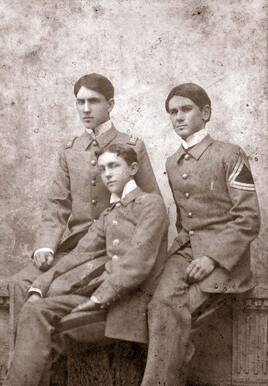 Donald Comer, at left, with two classmates at the Bingham Military School, Asheville, North Carolina, c. 1896–1897. (Alabama Department of Archives and History)
Donald Comer, at left, with two classmates at the Bingham Military School, Asheville, North Carolina, c. 1896–1897. (Alabama Department of Archives and History)
Donald Comer’s Great Adventure in the Philippines, 1899-1902
by David E. Alsobrook
Donald Comer is best known for his role as the driving force behind Avondale Mills, the Alabama textile conglomerate. However, immediately prior to assuming the role of mill manager, Comer was pursuing an Army career. His service in the Philippines provided him with ample experience in combat, but it also instilled in him a sense of leadership, and service—qualities that served him well in his future role as a businessman and executive.
About the Author
David E. Alsobrook was born in Eufaula, Alabama, and grew up in Mobile, where he currently resides with his wife, Ellen. He earned graduate history degrees at West Virginia University and Auburn University. He served as an archivist at the Alabama Department of Archives and History (ADAH), supervisory archivist at the Jimmy Carter Presidential Library, and as the founding director of the George H. W. Bush and William J. Clinton Presidential Libraries. His earlier article in Alabama Heritage became the genesis for his book, Southside: Eufaula’s Cotton Mill Village and its People, 1890–1945, published by Mercer University Press (MUP) in 2017 and recipient of the Alabama Historical Association’s C. J. Coley Award the following year. MUP also will publish his forthcoming work, Presidential Archivist: A Memoir, in December 2020. Special thanks to Scotty E. Kirkland at ADAH for his expert assistance with this article about Donald Comer.
Additional Information
To learn more about Donald Comer, see his profile on Encyclopedia of Alabama: http://www.encyclopediaofalabama.org/article/h-2616
by David E. Alsobrook
Donald Comer is best known for his role as the driving force behind Avondale Mills, the Alabama textile conglomerate. However, immediately prior to assuming the role of mill manager, Comer was pursuing an Army career. His service in the Philippines provided him with ample experience in combat, but it also instilled in him a sense of leadership, and service—qualities that served him well in his future role as a businessman and executive.
About the Author
David E. Alsobrook was born in Eufaula, Alabama, and grew up in Mobile, where he currently resides with his wife, Ellen. He earned graduate history degrees at West Virginia University and Auburn University. He served as an archivist at the Alabama Department of Archives and History (ADAH), supervisory archivist at the Jimmy Carter Presidential Library, and as the founding director of the George H. W. Bush and William J. Clinton Presidential Libraries. His earlier article in Alabama Heritage became the genesis for his book, Southside: Eufaula’s Cotton Mill Village and its People, 1890–1945, published by Mercer University Press (MUP) in 2017 and recipient of the Alabama Historical Association’s C. J. Coley Award the following year. MUP also will publish his forthcoming work, Presidential Archivist: A Memoir, in December 2020. Special thanks to Scotty E. Kirkland at ADAH for his expert assistance with this article about Donald Comer.
Additional Information
To learn more about Donald Comer, see his profile on Encyclopedia of Alabama: http://www.encyclopediaofalabama.org/article/h-2616
Alabama League of Municipalities
Promoting and Protecting Local Government Since 1935
By Carrie Banks
For more than eight decades, the Alabama League of Municipalities has helped the state’s cities and towns, providing resources, advocacy, and support. Carrie Banks explores the organization’s founding during the Great Depression and its history up into the Twenty-First Century, detailing the many ways it supports Alabama’s communities.
About the Author
Carrie Banks is originally from rural southeastern North Carolina, and she received her BA in journalism from East Carolina University and her MA in public relations and advertising from the University of Alabama. Since 1997 she has served as the communications director for the Alabama League of Municipalities (ALM), where she oversees the communications/marketing and strategic planning efforts for ALM and its affiliate organizations. She has taught “Fundamentals of Speech” as an adjunct instructor for Troy University, Montgomery, and has served on several statewide boards and committees, including the David Mathews Center for Civic Life and the Alabama Bicentennial Advisory Committee. She enjoys working in her yard, reading on her screened porch, and spending quality time with her two dogs—both rescues. She and her husband, Craig, are master-level scuba divers, outdoor enthusiasts, and occasional DIY home-improvement adventurists.
Additional Information
Alabama League of Municipalities: https://almonline.org/
Promoting and Protecting Local Government Since 1935
By Carrie Banks
For more than eight decades, the Alabama League of Municipalities has helped the state’s cities and towns, providing resources, advocacy, and support. Carrie Banks explores the organization’s founding during the Great Depression and its history up into the Twenty-First Century, detailing the many ways it supports Alabama’s communities.
About the Author
Carrie Banks is originally from rural southeastern North Carolina, and she received her BA in journalism from East Carolina University and her MA in public relations and advertising from the University of Alabama. Since 1997 she has served as the communications director for the Alabama League of Municipalities (ALM), where she oversees the communications/marketing and strategic planning efforts for ALM and its affiliate organizations. She has taught “Fundamentals of Speech” as an adjunct instructor for Troy University, Montgomery, and has served on several statewide boards and committees, including the David Mathews Center for Civic Life and the Alabama Bicentennial Advisory Committee. She enjoys working in her yard, reading on her screened porch, and spending quality time with her two dogs—both rescues. She and her husband, Craig, are master-level scuba divers, outdoor enthusiasts, and occasional DIY home-improvement adventurists.
Additional Information
Alabama League of Municipalities: https://almonline.org/
DEPARTMENT ABSTRACTS
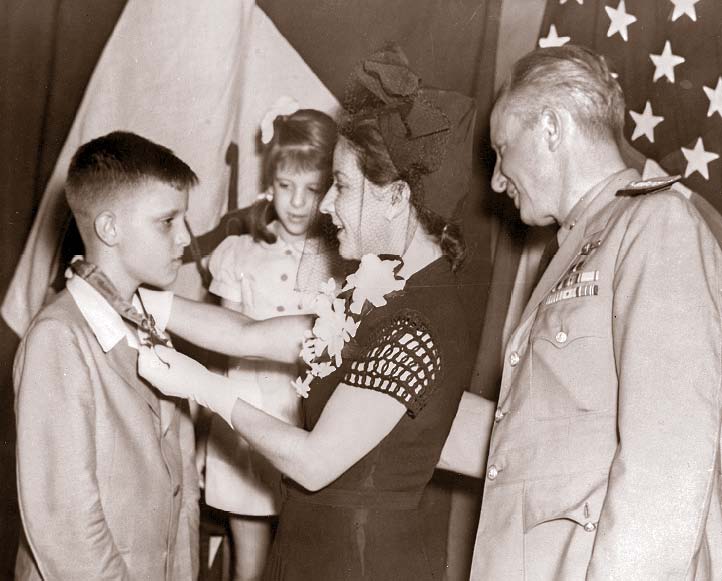 Commander Howard Gilmore’s widow and their children participated in the 1943 ceremony posthumously awarding him the Medal of Honor. (Naval History Heritage and Command)
Commander Howard Gilmore’s widow and their children participated in the 1943 ceremony posthumously awarding him the Medal of Honor. (Naval History Heritage and Command)
Portraits and Landscapes
Final Words of an Alabama Legend
By Chuck Lyons
During World War II in the waters near the Solomon Islands, an Alabama submarine commander lost his life—and saved his vessel and its crew, cementing his place as one of the state’s heroes in the process. Commander Howard Gilmore’s twenty-plus years of military service culminated in the fateful moment when he commanded his crew to take the submarine down, knowing that doing so would prevent his reentry but protect the USS Growler from the enemy fire pummeling it. His heroism earned him a posthumous Medal of Honor, which was accepted by his widow and their children.
About the Author
Chuck Lyons is a retired newspaper editor and a freelance history writer who resides in Rochester, New York, with his wife Brenda and a golden retriever named Jack.
Additional Information
Learn more about Gilmore at the Medal of Honor Museum, https://mohmuseum.org/howardgilmore/.
Final Words of an Alabama Legend
By Chuck Lyons
During World War II in the waters near the Solomon Islands, an Alabama submarine commander lost his life—and saved his vessel and its crew, cementing his place as one of the state’s heroes in the process. Commander Howard Gilmore’s twenty-plus years of military service culminated in the fateful moment when he commanded his crew to take the submarine down, knowing that doing so would prevent his reentry but protect the USS Growler from the enemy fire pummeling it. His heroism earned him a posthumous Medal of Honor, which was accepted by his widow and their children.
About the Author
Chuck Lyons is a retired newspaper editor and a freelance history writer who resides in Rochester, New York, with his wife Brenda and a golden retriever named Jack.
Additional Information
Learn more about Gilmore at the Medal of Honor Museum, https://mohmuseum.org/howardgilmore/.
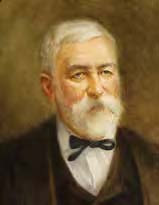
Alabama Governors
William Hugh Smith (1868-1870)
By Samuel L. Webb
Alabama’s twenty-first governor, William Hugh Smith, was the state’s first Republican elected to the governorship. In the tumultuous years after the Civil War, governing in the South posed numerous challenges, and Smith failed to overcome them. His decisions angered opponents and even members of his own party, leading to his defeat after a single term.
About the Author
Samuel L. Webb holds a JD from the University of Alabama School of Law and a PhD in history from the University of Arkansas. This department is drawn from Alabama Governors: A Political History of the State, second edition, edited by Webb and Margaret E. Armbrester (University of Alabama Press, 2014).
Additional Resources
Encyclopedia of Alabama: http://encyclopediaofalabama.org/article/h-2007
William Hugh Smith (1868-1870)
By Samuel L. Webb
Alabama’s twenty-first governor, William Hugh Smith, was the state’s first Republican elected to the governorship. In the tumultuous years after the Civil War, governing in the South posed numerous challenges, and Smith failed to overcome them. His decisions angered opponents and even members of his own party, leading to his defeat after a single term.
About the Author
Samuel L. Webb holds a JD from the University of Alabama School of Law and a PhD in history from the University of Arkansas. This department is drawn from Alabama Governors: A Political History of the State, second edition, edited by Webb and Margaret E. Armbrester (University of Alabama Press, 2014).
Additional Resources
Encyclopedia of Alabama: http://encyclopediaofalabama.org/article/h-2007
Adventures in Genealogy
Creel v. Creel: Divorce and its Many Layers
by Carlie Anne Burkett
Sometimes genealogists find fascinating resources in unexpected places. Descendants of one Mississippi family, the Rev. Albert E. Creel family, have much to learn from divorce records housed at the Alabama Department of Archives and History. Thanks to the family’s mobility and the contentious nature of the divorce, many personal details appear in the records, including accusations regarding paternity of some of the couple’s offspring.
About the Author
Carlie Anne Burkett has been a reference archivist at the Alabama Department of Archives and History since 2017. She holds a bachelor’s degree in history from the University of Alabama and a master’s degree from the University of Southern Mississippi. Working in the research room allows her to fulfill her dream of helping others research history every day.
Creel v. Creel: Divorce and its Many Layers
by Carlie Anne Burkett
Sometimes genealogists find fascinating resources in unexpected places. Descendants of one Mississippi family, the Rev. Albert E. Creel family, have much to learn from divorce records housed at the Alabama Department of Archives and History. Thanks to the family’s mobility and the contentious nature of the divorce, many personal details appear in the records, including accusations regarding paternity of some of the couple’s offspring.
About the Author
Carlie Anne Burkett has been a reference archivist at the Alabama Department of Archives and History since 2017. She holds a bachelor’s degree in history from the University of Alabama and a master’s degree from the University of Southern Mississippi. Working in the research room allows her to fulfill her dream of helping others research history every day.
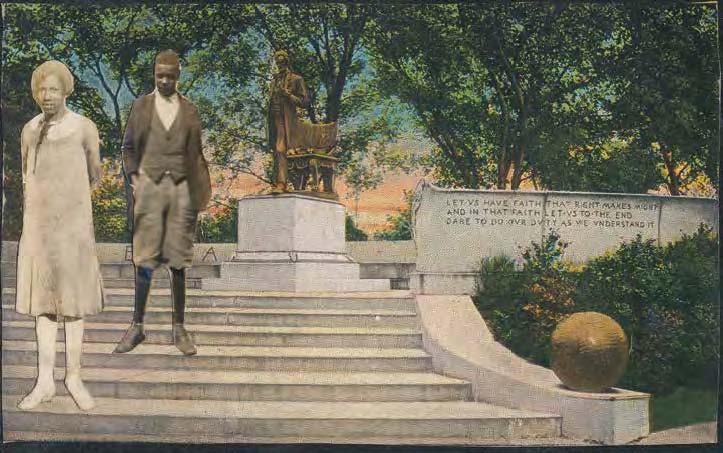 Two young African Americans collaged onto a postcard of the Abraham Lincoln monument in Lincoln Park, Chicago, Illinois. The postcard was found in an album in Limestone County, Alabama, with the collage likely produced sometime during the 1920s. (Limestone County Archives, Athens, Alabama)
Two young African Americans collaged onto a postcard of the Abraham Lincoln monument in Lincoln Park, Chicago, Illinois. The postcard was found in an album in Limestone County, Alabama, with the collage likely produced sometime during the 1920s. (Limestone County Archives, Athens, Alabama)
Behind the Image
A Visit with Abraham Lincoln
By Frances Osborn Robb
Though sculptor August Saint-Gaudens is commonly associated with New England, the effects of his work resonated with people throughout the United States. Indeed, his sculptures of Abraham Lincoln gained such renown that people traveled to see them, preserving memories of their visits in unique and compelling ways. Frances Osborn Robb reports on one such memory, likely associated with Limestone County’s Trinity School, which preserves the image of two young African Americans at the steps of Saint-Gaudens’s statue.
About the Author
Frances Osborn Robb is the contributing editor for the “Behind the Image” department of Alabama Heritage. She is the author of Shot in Alabama: A History of Photography, 1839–1941, and a List of Photographers (University of Alabama Press, 2017). She is passionate about historic photographs.
Additional Resources
Shot in Alabama https://www.amazon.com/Shot-Alabama-Photography-1839-1941-Photographers/dp/081731878X
A Visit with Abraham Lincoln
By Frances Osborn Robb
Though sculptor August Saint-Gaudens is commonly associated with New England, the effects of his work resonated with people throughout the United States. Indeed, his sculptures of Abraham Lincoln gained such renown that people traveled to see them, preserving memories of their visits in unique and compelling ways. Frances Osborn Robb reports on one such memory, likely associated with Limestone County’s Trinity School, which preserves the image of two young African Americans at the steps of Saint-Gaudens’s statue.
About the Author
Frances Osborn Robb is the contributing editor for the “Behind the Image” department of Alabama Heritage. She is the author of Shot in Alabama: A History of Photography, 1839–1941, and a List of Photographers (University of Alabama Press, 2017). She is passionate about historic photographs.
Additional Resources
Shot in Alabama https://www.amazon.com/Shot-Alabama-Photography-1839-1941-Photographers/dp/081731878X
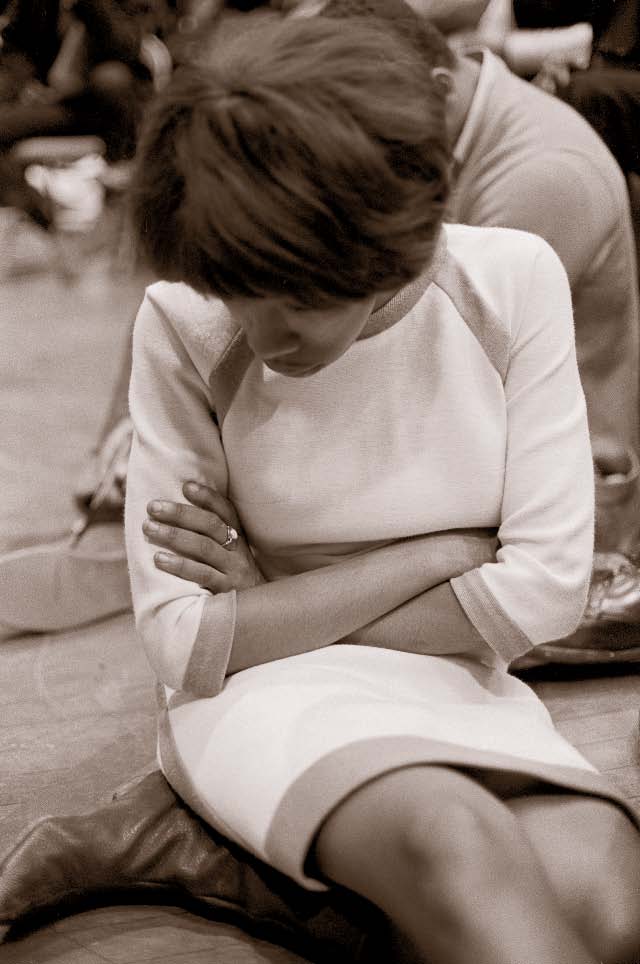
From the Archives
Glimpses of Gwen Patton
By Justin Rudder
Editor’s Note: The “From the Archives” columns during 2020, the centennial of women’s suffrage, will focus on the important roles of women in Alabama history.
This quarter’s installment of “From the Archives” explores items from the Alabama Department of Archives and History’s (ADAH) collection connected to Gwen Patton, an activist and scholar whose mentorship influenced many of the state’s young people—including current members of the ADAH staff. Patton’s role in the civil rights movement and her work at the state’s educational institutions, including Tuskegee University, reflect her life of activism and service.
About the Author
Justin Rudder is a digital assets archivist at the Alabama Department of Archives and History. During Patton’s final years, he was her colleague, friend, and occasional chauffeur.
Additional Information
For an interview with Gwen Patton, please see the Library of Congress: https://www.loc.gov/item/2015669119/
Glimpses of Gwen Patton
By Justin Rudder
Editor’s Note: The “From the Archives” columns during 2020, the centennial of women’s suffrage, will focus on the important roles of women in Alabama history.
This quarter’s installment of “From the Archives” explores items from the Alabama Department of Archives and History’s (ADAH) collection connected to Gwen Patton, an activist and scholar whose mentorship influenced many of the state’s young people—including current members of the ADAH staff. Patton’s role in the civil rights movement and her work at the state’s educational institutions, including Tuskegee University, reflect her life of activism and service.
About the Author
Justin Rudder is a digital assets archivist at the Alabama Department of Archives and History. During Patton’s final years, he was her colleague, friend, and occasional chauffeur.
Additional Information
For an interview with Gwen Patton, please see the Library of Congress: https://www.loc.gov/item/2015669119/
Reading the Southern Past
The Federal Road
By Stephen Goldfarb
This quarter’s installment of “Reading the Southern Past” considers the Federal Road, whose passage through Alabama shaped the young state’s character. Under consideration are The Federal Road Through Georgia, the Creek Nation, and Alabama, 1806–1836 by Henry deLeon Southerland Jr. and Jerry Elijah Brown (University of Alabama Press, 1989); The Very Worst Road: Travelers’ Accounts of Crossing Alabama’s Old Creek Indian Territory, 1820–1847 (University of Alabama Press, 1998) an anthology compiled by Jeffrey C. Benton; and The Old Federal Road in Alabama by Kathryn H. Braund, Gregory A. Waselkov, and Raven M. Christopher (University of Alabama Press, 2019).
About the Author
Stephen Goldfarb holds a PhD in the history of science and technology. He retired from a public library in 2003.
Additional Resources
Benton:
https://www.amazon.com/Very-Worst-Road-Travellers-Territory/dp/0817355502
Braund, Waselkov, Christopher:
https://www.amazon.com/Old-Federal-Road-Alabama-Illustrated/dp/0817359303
Southerland and Brown:
https://www.amazon.com/Federal-Through-Georgia-Alabama-1806-1836/dp/0817305181
The Federal Road
By Stephen Goldfarb
This quarter’s installment of “Reading the Southern Past” considers the Federal Road, whose passage through Alabama shaped the young state’s character. Under consideration are The Federal Road Through Georgia, the Creek Nation, and Alabama, 1806–1836 by Henry deLeon Southerland Jr. and Jerry Elijah Brown (University of Alabama Press, 1989); The Very Worst Road: Travelers’ Accounts of Crossing Alabama’s Old Creek Indian Territory, 1820–1847 (University of Alabama Press, 1998) an anthology compiled by Jeffrey C. Benton; and The Old Federal Road in Alabama by Kathryn H. Braund, Gregory A. Waselkov, and Raven M. Christopher (University of Alabama Press, 2019).
About the Author
Stephen Goldfarb holds a PhD in the history of science and technology. He retired from a public library in 2003.
Additional Resources
Benton:
https://www.amazon.com/Very-Worst-Road-Travellers-Territory/dp/0817355502
Braund, Waselkov, Christopher:
https://www.amazon.com/Old-Federal-Road-Alabama-Illustrated/dp/0817359303
Southerland and Brown:
https://www.amazon.com/Federal-Through-Georgia-Alabama-1806-1836/dp/0817305181
